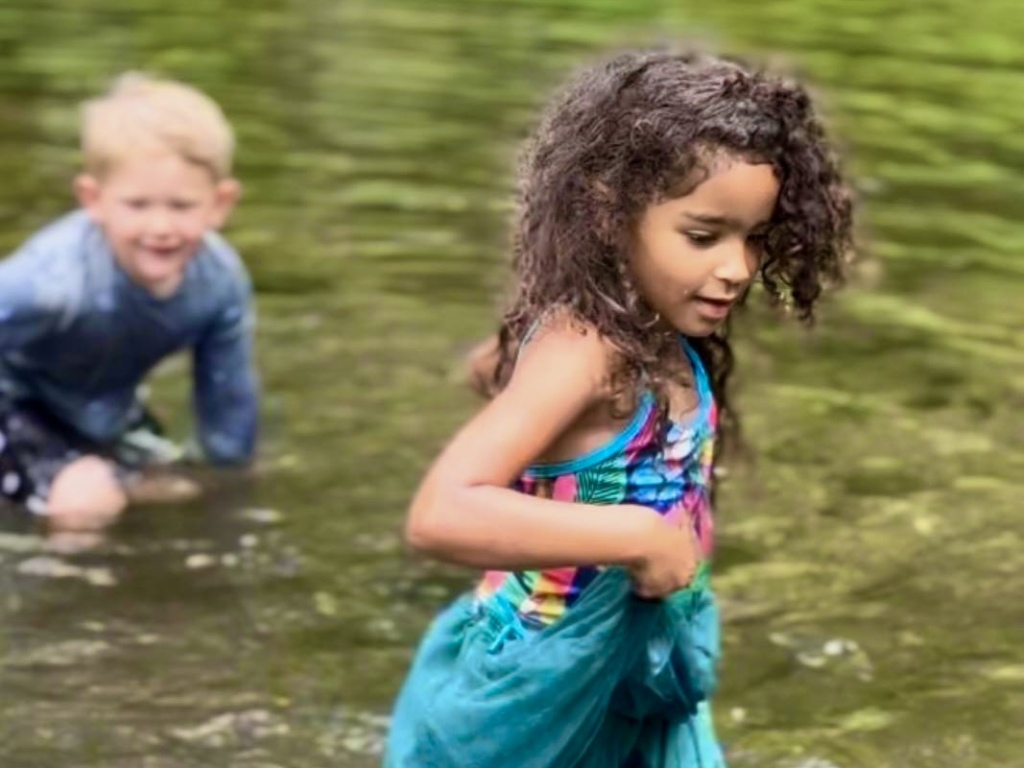Inspired by Indigenous practice with stewardship of the land and ancestral skills, counselors guide kids in the city in the “old ways.”

Imagine a day spent wandering in the Wissahickon woods. You start by looking for bluegill nests, fish that lay eggs and produce naturally in the Wissahickon Creek. But, it rained three inches the night before, and the creek was too full. So, you pivot, find some slate rock, and start grinding it into a sharp edge into a knife, which you can use to cut apart fallen branches for building a fire later in the afternoon.
This is the kind of experiential knowledge 4 Elements Earth Education (4EEE) teaches adults and children. In Philadelphia, the organization hosts the Tiny Tracks and Coyote Tracks programs, teaching wilderness survival skills and what it calls “ancient awareness” to children ages three to twelve.
Tom Brown Jr., a renowned wilderness expert, and owner and operator of the Tom Brown Jr. Tracking School, a wilderness skills program in the South Jersey Pine Barrens, was the inspiration for the 4EEE organization. Brown Jr. was taught by Stalking Wolf, an Apache indigenous elder. He trained Brown Jr. in ancient awareness tracking skills, wilderness and survival techniques, and more. Brown Jr. went on to create the school in New Jersey to teach everything he learned from Stalking Wolf. Brown Jr. recently passed away, leaving a legacy of past knowledge and wilderness experiences to younger and older students alike.
Juan Villarreal, of the Lipan Apache Tribe of Texas, has the same lineage as Stalking Wolf. He has worked with the 4 Elements Earth Education organization. He brings what he calls the “old ways”–ancestral skills and a gentle way of being with the earth and its creatures.
His work centers on his homeland of the Red Sun Ranch in Texas, but the programs that run in Philadelphia are inspired by his guidance.
He wants people to know that the way to teach children, and people in general, about the land is to remember an old saying–what you don’t understand, recognize, or love, you have a tendency to destroy. He says programs like these can foster stewardship with the land and parks in cities because they can show people how connected we are to the nature around us.
Jamie Coyle, program director of Coyote Tracks, is from Philadelphia. He says he didn’t grow up in nature, nor did he learn survival skills at a young age. As an older teen, his cousin introduced him to a free class by the Tom Brown Jr. Tracking School. Coyle went to one camping experience at the tracking school and was hooked. He kept returning to their adult workshops and camping trips and soon became an official part of the staff as the program became the non-profit 4 Elements Earth Education (4EEE).
The organization runs programs in New Jersey, California, Texas, and Pennsylvania, right in Northwest Philadelphia, in the Wissahickon Woods.
Coyle is the program director for the Philadelphia branch and just finished leading a Coyote Tracks summer camp program. Fall afterschool and homeschooling sessions have started this month.
Christine Loveless is a Germantown neighbor, nurse, and mother to five-year-old Niana Oliver. She heard of the tracking school before, but it wasn’t until she ran into folks from the Coyote Tracks program at Smith Playground when Niana was three years old that they got involved.
Niana couldn’t get enough of their Tiny Tracks programs, being outside and learning about nature. She’s been a part of their activities since recently finishing the summer camp program. Villarreal says children are naturally drawn to plants and colorful flowers, and the experiences and what they are drawn to in nature are very intuitive.
“A child … they have a tendency to, if it’s real cold, well, they’re going to get under leaves and things like that. Naturally they’re very, very good with outdoor philosophies, native philosophies that we teach because it’s about giving into your surroundings, you know, and as adults, we tend to not believe that things could be so simple. So we create our own illusion of difficulty, living or being out in the woods, the fear of it, and so many things,” says Villarreal.
Loveless really appreciated the unstructured flow of their days and their emphasis on self-directed learning and liked the fact that the entire program is outside. She knew Niana could explore at her own pace, completely outside. “[I like that] they are exclusively outdoors because she has the whole rest of her life to possibly be trapped in a box for school and work,” said Loveless.
The typical camp day started in Historic Rittenhouse Town. Camp counselors would lay out different open-ended materials like animal skulls, rocks and crystals, plant identification books, and other natural items for the kids to explore. They were free to wander and wonder, with children playing with the materials or checking out the natural landscape around them.
Then they gathered in a circle and shared their names and what they were thankful for that day. Then, some kind of storytelling takes place, which is an important part of the cultures they are trying to preserve. Then they went off on different hikes or explorations.
Coyle details how kids are able to channel the “old ways” to create the most valuable items in the wild from the most simple materials.
“Well, there’s a lot of slate and things that you can find in the Wissahickon, and you can grind them on river rocks that are smooth, and you throw some sand in some water, and you grind them down all of a sudden… then you can get a little stick and carve a little notch into it so the stone can go into the stick. And then all of a sudden, you have a knife. And it’s a very uplifting feeling, especially for kids. I mean, you see any kid with a stick and a rock, they’re trying to put them together. It’s an easy sell, and it seems to give them a lot of self-confidence,” he said.
Much of the work done was unstructured and timeless. Most activities were done in a figure-it-out-for-yourself way. One example of an activity for the older kids to get them to notice the nature around them was telling them to take pictures and reels for Instagram with their minds.
Coyle continued, “There’s these little clam shells, some type of freshwater clam in the Wissahickon stones, and you can get a little hole in them. And then we were making rope out of natural plants, plant fibers, like sting, nettle, dogbane, milkweed. There’s a bunch of plants that make fibers, and you can twist them into something like a rope. And we put them on a stick shaped like a Y with all these different shells. And you make little rattles, you know, like little instruments and stuff.”
They would get sent off on their own to different parts of the woods and directed to just sit there for at least 10 minutes. Afterward, they returned and needed to tell the other campers about their mental pictures and videos.
At the end of the day, they made their way back to Rittenhousetown, once again joined in a circle, and shared again what they were grateful for. Villarreal says an important part of learning these ancestral ways is learning how much of a gift everything is around you.
“You carry yourself differently, not in an arrogant, confident way, but understanding that you’re not ever by yourself. Because you’re surrounded by things that are here to care for you, to provide for you,” says Villarreal.
He wants people to realize that his people, the Lipan Apache, are survivors of an attempted genocide. His grandfather was born in 1862, and he grew up with the effects of that environment. And to see these kinds of programs taught now in different parts of the country is something very emotional for him.
“And now they’re (the old ways) being taught to children. It’s just… I want to literally cry over that because it’s so powerful. It’s just, you know, part of being human and compassionate and loving, and it’s all, you know, being respectful,” says Villarreal.
Afterschool programs for the fall meet at the Wissahickon Environmental Center and will explore the Wissahickon woods. There is also a Young Coyote Tracks program for five to seven-year-olds that meet during the day in Historic Rittenhousetown.
To find out more about Coyote Tracks, use the 4EEE website’s contact form. All Philadelphia programs work on a sliding scale. A Coyote Tracks Family Campout Fundraiser will be held on October 12 and 13, 2024, in Fort Washington State Park. All funds raised will help support Philadelphia programming.



